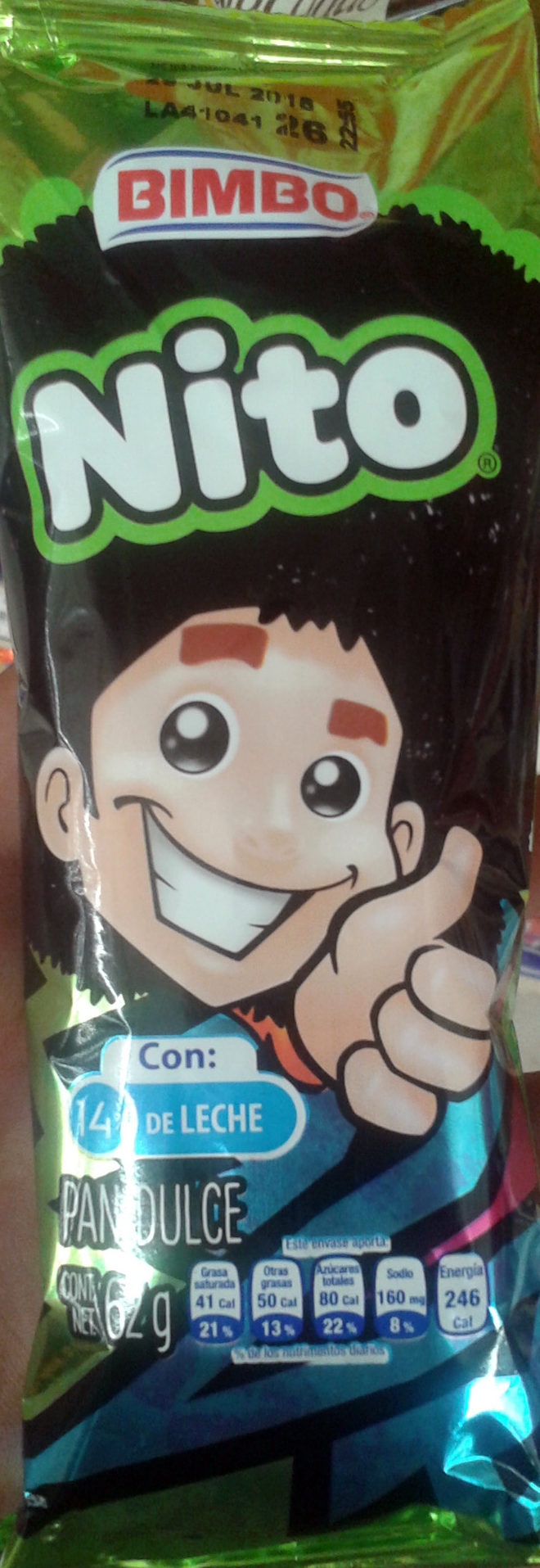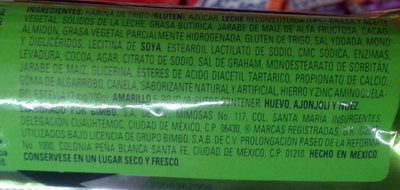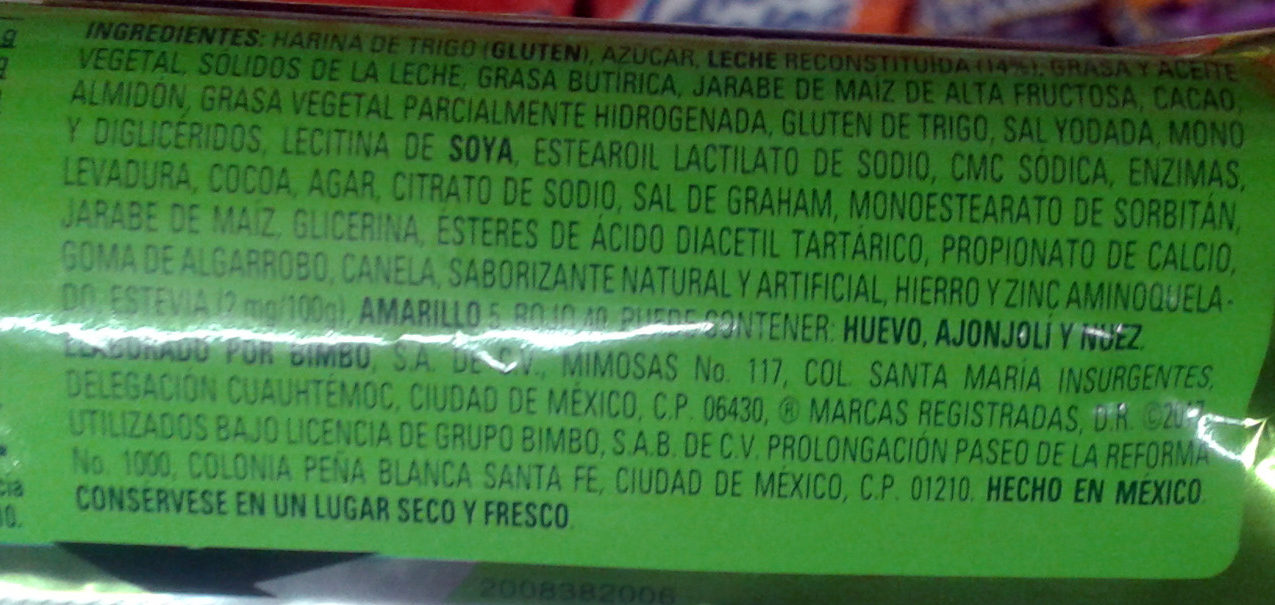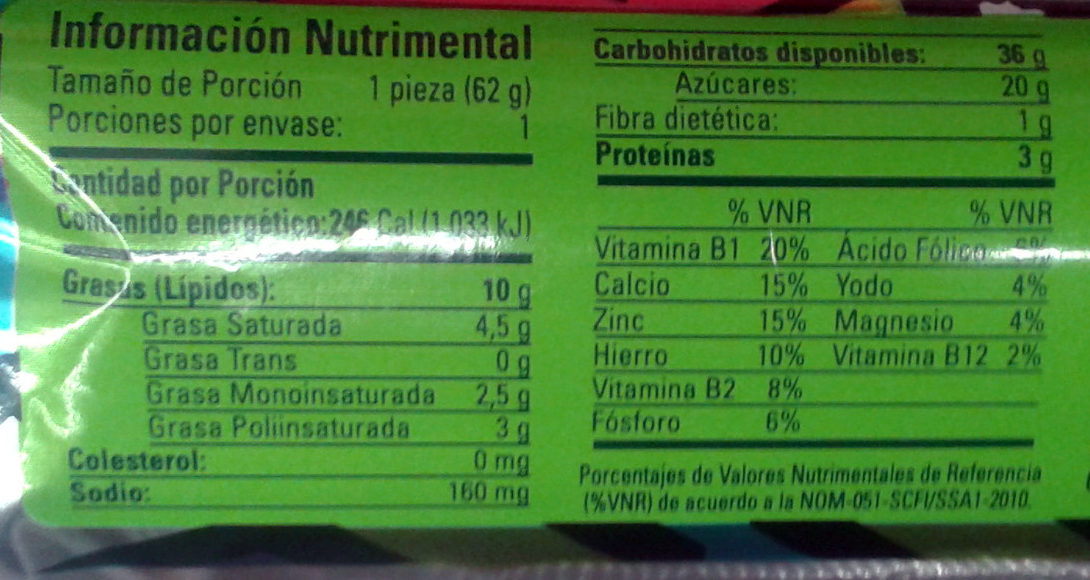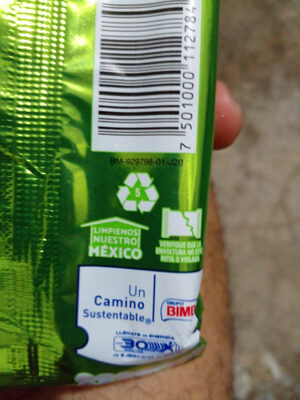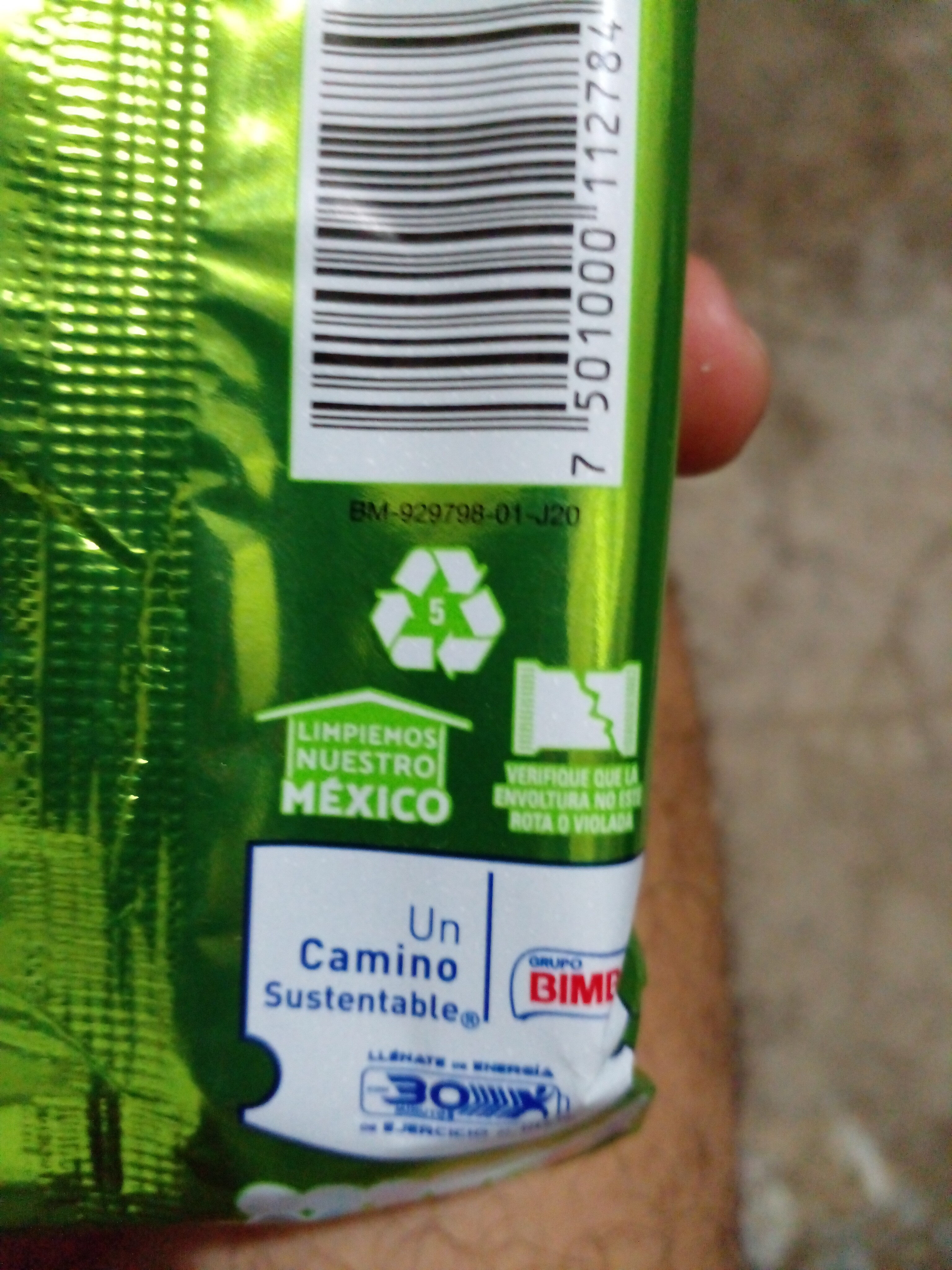Help us make food transparency the norm!
As a non-profit organization, we depend on your donations to continue informing consumers around the world about what they eat.
The food revolution starts with you!
Nito - Bimbo - 62 g
Nito - Bimbo - 62 g
This product page is not complete. You can help to complete it by editing it and adding more data from the photos we have, or by taking more photos using the app for Android or iPhone/iPad. Thank you!
×
Barcode: 7501000112784 (EAN / EAN-13)
Common name: Pan relleno de chocolate y con cubierta de chocolate
Quantity: 62 g
Packaging: Plastic
Brands: Bimbo, Bimbo S.A. de C.V.
Categories: Plant-based foods and beverages, Plant-based foods, Snacks, Cereals and potatoes, Sweet snacks, Biscuits and cakes, Breads, Cakes
Labels, certifications, awards: es:Sembrando Juntos
Manufacturing or processing places: Ciudad de México, México
Countries where sold: Mexico
Matching with your preferences
Health
Ingredients
-
35 ingredients
Spanish: Harina de trigo (gluten), azúcar, leche reconstruida 14%, grasa y aceite vegetal, sólidos de la leche, grasa butírica, jarabe de maíz de alta fructosa, cacao, almidón, grasa vegetal parcialmente hidrogenada, gluten de trigo, sal yodada, mono y diglicéridos, lecitina de soya, estearoil lactilato de sodio, CMC sódica, enzimas, levadura, cocoa, agar, citrato de sodio, sal de graham, monoestearato de sorbitán, jarabe de maíz, glicerina, ésteres de ácido diacetil tartárico, propionato de calcio, goma de algarrobo, canela, saborizante natural y artificial, hierro y zinc aminoquelado, estevia (2 mg/100 g), amarillo 5, rojo 40Allergens: Gluten, SoybeansTraces: Eggs, Nuts, Sesame seeds
Food processing
-
Ultra processed foods
Elements that indicate the product is in the 4 - Ultra processed food and drink products group:
- Additive: E102 - Tartrazine
- Additive: E129 - Allura red
- Additive: E322 - Lecithins
- Additive: E406 - Agar
- Additive: E410 - Locust bean gum
- Additive: E422 - Glycerol
- Additive: E466 - Sodium carboxy methyl cellulose
- Additive: E481 - Sodium stearoyl-2-lactylate
- Additive: E960 - Steviol glycosides
- Ingredient: Flavouring
- Ingredient: Glucose
- Ingredient: Gluten
- Ingredient: High fructose corn syrup
- Ingredient: Hydrogenated fat
Food products are classified into 4 groups according to their degree of processing:
- Unprocessed or minimally processed foods
- Processed culinary ingredients
- Processed foods
- Ultra processed foods
The determination of the group is based on the category of the product and on the ingredients it contains.
Additives
-
E102 - Tartrazine
Tartrazine: Tartrazine is a synthetic lemon yellow azo dye primarily used as a food coloring. It is also known as E number E102, C.I. 19140, FD&C Yellow 5, Acid Yellow 23, Food Yellow 4, and trisodium 1--4-sulfonatophenyl--4--4-sulfonatophenylazo--5-pyrazolone-3-carboxylate-.Tartrazine is a commonly used color all over the world, mainly for yellow, and can also be used with Brilliant Blue FCF -FD&C Blue 1, E133- or Green S -E142- to produce various green shades.Source: Wikipedia
-
E129 - Allura red
Allura Red AC: Allura Red AC is a red azo dye that goes by several names, including FD&C Red 40. It is used as a food dye and has the E number E129. It is usually supplied as its red sodium salt, but can also be used as the calcium and potassium salts. These salts are soluble in water. In solution, its maximum absorbance lies at about 504 nm.Source: Wikipedia
-
E282 - Calcium propionate
Calcium propanoate: Calcium propanoate or calcium propionate has the formula Ca-C2H5COO-2. It is the calcium salt of propanoic acid.Source: Wikipedia
-
E322 - Lecithins
Lecithins are natural compounds commonly used in the food industry as emulsifiers and stabilizers.
Extracted from sources like soybeans and eggs, lecithins consist of phospholipids that enhance the mixing of oil and water, ensuring smooth textures in various products like chocolates, dressings, and baked goods.
They do not present any known health risks.
-
E322i - Lecithin
Lecithins are natural compounds commonly used in the food industry as emulsifiers and stabilizers.
Extracted from sources like soybeans and eggs, lecithins consist of phospholipids that enhance the mixing of oil and water, ensuring smooth textures in various products like chocolates, dressings, and baked goods.
They do not present any known health risks.
-
E331 - Sodium citrates
Sodium citrate: Sodium citrate may refer to any of the sodium salts of citrate -though most commonly the third-: Monosodium citrate Disodium citrate Trisodium citrateThe three forms of the salt are collectively known by the E number E331. Sodium citrates are used as acidity regulators in food and drinks, and also as emulsifiers for oils. They enable cheeses to melt without becoming greasy.Source: Wikipedia
-
E406 - Agar
Agar: Agar -pronounced , sometimes - or agar-agar is a jelly-like substance, obtained from red algae.Agar is a mixture of two components: the linear polysaccharide agarose, and a heterogeneous mixture of smaller molecules called agaropectin. It forms the supporting structure in the cell walls of certain species of algae, and is released on boiling. These algae are known as agarophytes, and belong to the Rhodophyta -red algae- phylum.Agar has been used as an ingredient in desserts throughout Asia, and also as a solid substrate to contain culture media for microbiological work. Agar can be used as a laxative, an appetite suppressant, a vegetarian substitute for gelatin, a thickener for soups, in fruit preserves, ice cream, and other desserts, as a clarifying agent in brewing, and for sizing paper and fabrics.The gelling agent in agar is an unbranched polysaccharide obtained from the cell walls of some species of red algae, primarily from tengusa -Gelidiaceae- and ogonori -Gracilaria-. For commercial purposes, it is derived primarily from ogonori. In chemical terms, agar is a polymer made up of subunits of the sugar galactose.Source: Wikipedia
-
E410 - Locust bean gum
Locust bean gum: Locust bean gum -LBG, also known as carob gum, carob bean gum, carobin, E410- is a thickening agent and a gelling agent used in food technology.Source: Wikipedia
-
E422 - Glycerol
Glycerol: Glycerol -; also called glycerine or glycerin; see spelling differences- is a simple polyol compound. It is a colorless, odorless, viscous liquid that is sweet-tasting and non-toxic. The glycerol backbone is found in all lipids known as triglycerides. It is widely used in the food industry as a sweetener and humectant and in pharmaceutical formulations. Glycerol has three hydroxyl groups that are responsible for its solubility in water and its hygroscopic nature.Source: Wikipedia
-
E466 - Sodium carboxy methyl cellulose
Carboxymethyl cellulose: Carboxymethyl cellulose -CMC- or cellulose gum or tylose powder is a cellulose derivative with carboxymethyl groups --CH2-COOH- bound to some of the hydroxyl groups of the glucopyranose monomers that make up the cellulose backbone. It is often used as its sodium salt, sodium carboxymethyl cellulose.Source: Wikipedia
-
E481 - Sodium stearoyl-2-lactylate
Sodium stearoyl lactylate: Sodium stearoyl-2-lactylate -sodium stearoyl lactylate or SSL- is a versatile, FDA approved food additive used to improve the mix tolerance and volume of processed foods. It is one type of a commercially available lactylate. SSL is non-toxic, biodegradable, and typically manufactured using biorenewable feedstocks. Because SSL is a safe and highly effective food additive, it is used in a wide variety of products ranging from baked goods and desserts to pet foods.As described by the Food Chemicals Codex 7th edition, SSL is a cream-colored powder or brittle solid. SSL is currently manufactured by the esterification of stearic acid with lactic acid and partially neutralized with either food-grade soda ash -sodium carbonate- or caustic soda -concentrated sodium hydroxide-. Commercial grade SSL is a mixture of sodium salts of stearoyl lactylic acids and minor proportions of other sodium salts of related acids. The HLB for SSL is 10-12. SSL is slightly hygroscopic, soluble in ethanol and in hot oil or fat, and dispersible in warm water. These properties are the reason that SSL is an excellent emulsifier for fat-in-water emulsions and can also function as a humectant.Source: Wikipedia
-
E960 - Steviol glycosides
Steviol glycoside: Steviol glycosides are the chemical compounds responsible for the sweet taste of the leaves of the South American plant Stevia rebaudiana -Asteraceae- and the main ingredients -or precursors- of many sweeteners marketed under the generic name stevia and several trade names. They also occur in the related species Stevia phlebophylla -but in no other species of Stevia- and in the plant Rubus chingii -Rosaceae-.Steviol glycosides from Stevia rebaudiana have been reported to be between 30 and 320 times sweeter than sucrose, although there is some disagreement in the technical literature about these numbers. They are heat-stable, pH-stable, and do not ferment. Additionally, they do not induce a glycemic response when ingested, because humans can not metabolize stevia. This makes them attractive as natural sugar substitutes for diabetics and other people on carbohydrate-controlled diets. Steviol glycosides stimulate the insulin secretion through potentiation of the β-cell, preventing high blood glucose after a meal. The acceptable daily intake -ADI- for steviol glycosides, expressed as steviol equivalents, has been established to be 4 mg/kg body weight/day, and is based on no observed effects of a 100 fold higher dose in a rat study.Source: Wikipedia
Ingredients analysis
-
May contain palm oil
Ingredients that may contain palm oil: Fat, Vegetable oil, Butterfat, Partially hydrogenated vegetable fat, E481
-
Non-vegan
Non-vegan ingredients: Milk solids, Butterfat, Partially hydrogenated vegetable fatSome ingredients could not be recognized.
We need your help!
You can help us recognize more ingredients and better analyze the list of ingredients for this product and others:
- Edit this product page to correct spelling mistakes in the ingredients list, and/or to remove ingredients in other languages and sentences that are not related to the ingredients.
- Add new entries, synonyms or translations to our multilingual lists of ingredients, ingredient processing methods, and labels.
If you would like to help, join the #ingredients channel on our Slack discussion space and/or learn about ingredients analysis on our wiki. Thank you!
-
Vegetarian status unknown
Unrecognized ingredients: es:leche-reconstruida, es:mono-y-digliceridos, Sodium citrate, es:sal-de-graham, es:monoestearato-de-sorbitan, es:esteres-de-acido-diacetil-tartarico, es:hierro-y-zinc-aminoqueladoSome ingredients could not be recognized.
We need your help!
You can help us recognize more ingredients and better analyze the list of ingredients for this product and others:
- Edit this product page to correct spelling mistakes in the ingredients list, and/or to remove ingredients in other languages and sentences that are not related to the ingredients.
- Add new entries, synonyms or translations to our multilingual lists of ingredients, ingredient processing methods, and labels.
If you would like to help, join the #ingredients channel on our Slack discussion space and/or learn about ingredients analysis on our wiki. Thank you!
-
Details of the analysis of the ingredients
We need your help!
Some ingredients could not be recognized.
We need your help!
You can help us recognize more ingredients and better analyze the list of ingredients for this product and others:
- Edit this product page to correct spelling mistakes in the ingredients list, and/or to remove ingredients in other languages and sentences that are not related to the ingredients.
- Add new entries, synonyms or translations to our multilingual lists of ingredients, ingredient processing methods, and labels.
If you would like to help, join the #ingredients channel on our Slack discussion space and/or learn about ingredients analysis on our wiki. Thank you!
es: Harina de trigo, azúcar, leche reconstruida 14%, grasa, aceite vegetal, sólidos de la leche, grasa butírica, jarabe de maíz de alta fructosa, cacao, almidón, grasa vegetal parcialmente hidrogenada, gluten de trigo, sal yodada, mono- y diglicéridos, lecitina de soya, estearoil lactilato de sodio, CMC sódica, enzimas, levadura, cocoa, agar, citrato de sodio, sal de graham, monoestearato de sorbitán, jarabe de maíz, glicerina, ésteres de ácido diacetil tartárico, propionato de calcio, goma de algarrobo, canela, saborizante natural y artificial, hierro y zinc aminoquelado, estevia, amarillo 5, rojo 40- Harina de trigo -> en:wheat-flour - vegan: yes - vegetarian: yes - ciqual_proxy_food_code: 9410 - percent_min: 14 - percent_max: 72
- azúcar -> en:sugar - vegan: yes - vegetarian: yes - ciqual_proxy_food_code: 31016 - percent_min: 14 - percent_max: 20
- leche reconstruida -> es:leche-reconstruida - percent_min: 14 - percent: 14 - percent_max: 14
- grasa -> en:fat - vegan: maybe - vegetarian: maybe - from_palm_oil: maybe - percent_min: 0 - percent_max: 14
- aceite vegetal -> en:vegetable-oil - vegan: yes - vegetarian: yes - from_palm_oil: maybe - percent_min: 0 - percent_max: 14
- sólidos de la leche -> en:milk-solids - vegan: no - vegetarian: yes - ciqual_proxy_food_code: 19051 - percent_min: 0 - percent_max: 14
- grasa butírica -> en:butterfat - vegan: no - vegetarian: yes - from_palm_oil: maybe - ciqual_food_code: 16401 - percent_min: 0 - percent_max: 14
- jarabe de maíz de alta fructosa -> en:high-fructose-corn-syrup - vegan: yes - vegetarian: yes - ciqual_food_code: 31077 - percent_min: 0 - percent_max: 12
- cacao -> en:cocoa - vegan: yes - vegetarian: yes - ciqual_proxy_food_code: 18100 - percent_min: 0 - percent_max: 10.2857142857143
- almidón -> en:starch - vegan: yes - vegetarian: yes - ciqual_proxy_food_code: 9510 - percent_min: 0 - percent_max: 9
- grasa vegetal parcialmente hidrogenada -> en:partially-hydrogenated-vegetable-fat - vegan: no - vegetarian: maybe - from_palm_oil: maybe - percent_min: 0 - percent_max: 8
- gluten de trigo -> en:wheat-gluten - vegan: yes - vegetarian: yes - percent_min: 0 - percent_max: 7.2
- sal yodada -> en:iodised-salt - vegan: yes - vegetarian: yes - ciqual_food_code: 11058 - percent_min: 0 - percent_max: 0.4064
- mono- y diglicéridos -> es:mono-y-digliceridos - percent_min: 0 - percent_max: 0.4064
- lecitina de soya -> en:soya-lecithin - vegan: yes - vegetarian: yes - ciqual_food_code: 42200 - percent_min: 0 - percent_max: 0.4064
- estearoil lactilato de sodio -> en:e481 - vegan: maybe - vegetarian: maybe - from_palm_oil: maybe - percent_min: 0 - percent_max: 0.4064
- CMC sódica -> en:e466 - vegan: yes - vegetarian: yes - percent_min: 0 - percent_max: 0.4064
- enzimas -> en:enzyme - vegan: maybe - vegetarian: maybe - percent_min: 0 - percent_max: 0.4064
- levadura -> en:yeast - vegan: yes - vegetarian: yes - ciqual_proxy_food_code: 11009 - percent_min: 0 - percent_max: 0.4064
- cocoa -> en:cocoa - vegan: yes - vegetarian: yes - ciqual_proxy_food_code: 18100 - percent_min: 0 - percent_max: 0.4064
- agar -> en:e406 - vegan: yes - vegetarian: yes - ciqual_food_code: 11084 - percent_min: 0 - percent_max: 0.4064
- citrato de sodio -> en:sodium-citrate - percent_min: 0 - percent_max: 0.4064
- sal de graham -> es:sal-de-graham - percent_min: 0 - percent_max: 0.4064
- monoestearato de sorbitán -> es:monoestearato-de-sorbitan - percent_min: 0 - percent_max: 0.4064
- jarabe de maíz -> en:corn-syrup - vegan: yes - vegetarian: yes - ciqual_proxy_food_code: 31089 - percent_min: 0 - percent_max: 0.4064
- glicerina -> en:e422 - vegan: maybe - vegetarian: maybe - percent_min: 0 - percent_max: 0.4064
- ésteres de ácido diacetil tartárico -> es:esteres-de-acido-diacetil-tartarico - percent_min: 0 - percent_max: 0.4064
- propionato de calcio -> en:e282 - vegan: yes - vegetarian: yes - percent_min: 0 - percent_max: 0.4064
- goma de algarrobo -> en:e410 - vegan: yes - vegetarian: yes - percent_min: 0 - percent_max: 0.4064
- canela -> en:cinnamon - vegan: yes - vegetarian: yes - percent_min: 0 - percent_max: 0.4064
- saborizante natural y artificial -> en:natural-and-artificial-flavouring - vegan: maybe - vegetarian: maybe - percent_min: 0 - percent_max: 0.4064
- hierro y zinc aminoquelado -> es:hierro-y-zinc-aminoquelado - percent_min: 0 - percent_max: 0.4064
- estevia -> en:e960 - vegan: yes - vegetarian: yes - percent_min: 0 - percent_max: 0.4064
- amarillo 5 -> en:e102 - vegan: yes - vegetarian: yes - percent_min: 0 - percent_max: 0.4064
- rojo 40 -> en:e129 - vegan: yes - vegetarian: yes - percent_min: 0 - percent_max: 0.4064
Nutrition
-
Poor nutritional quality
⚠ ️Warning: the amount of fruits, vegetables and nuts is not specified on the label, it was estimated from the list of ingredients: 0This product is not considered a beverage for the calculation of the Nutri-Score.
Positive points: 1
- Proteins: 1 / 5 (value: 3, rounded value: 3)
- Fiber: 1 / 5 (value: 1, rounded value: 1)
- Fruits, vegetables, nuts, and colza/walnut/olive oils: 0 / 5 (value: 0, rounded value: 0)
Negative points: 12
- Energy: 3 / 10 (value: 1033, rounded value: 1033)
- Sugars: 4 / 10 (value: 20, rounded value: 20)
- Saturated fat: 4 / 10 (value: 4.5, rounded value: 4.5)
- Sodium: 1 / 10 (value: 162.56, rounded value: 162.6)
The points for proteins are not counted because the negative points are greater or equal to 11.
Nutritional score: (12 - 1)
Nutri-Score:
-
Nutrient levels
-
Fat in moderate quantity (10%)
What you need to know- A high consumption of fat, especially saturated fats, can raise cholesterol, which increases the risk of heart diseases.
Recommendation: Limit the consumption of fat and saturated fat- Choose products with lower fat and saturated fat content.
-
Saturated fat in moderate quantity (4.5%)
What you need to know- A high consumption of fat, especially saturated fats, can raise cholesterol, which increases the risk of heart diseases.
Recommendation: Limit the consumption of fat and saturated fat- Choose products with lower fat and saturated fat content.
-
Sugars in high quantity (20%)
What you need to know- A high consumption of sugar can cause weight gain and tooth decay. It also augments the risk of type 2 diabetes and cardio-vascular diseases.
Recommendation: Limit the consumption of sugar and sugary drinks- Sugary drinks (such as sodas, fruit beverages, and fruit juices and nectars) should be limited as much as possible (no more than 1 glass a day).
- Choose products with lower sugar content and reduce the consumption of products with added sugars.
-
Salt in moderate quantity (0.406%)
What you need to know- A high consumption of salt (or sodium) can cause raised blood pressure, which can increase the risk of heart disease and stroke.
- Many people who have high blood pressure do not know it, as there are often no symptoms.
- Most people consume too much salt (on average 9 to 12 grams per day), around twice the recommended maximum level of intake.
Recommendation: Limit the consumption of salt and salted food- Reduce the quantity of salt used when cooking, and don't salt again at the table.
- Limit the consumption of salty snacks and choose products with lower salt content.
-
-
Nutrition facts
Nutrition facts As sold
for 100 g / 100 mlAs sold
per serving (62 g)Compared to: Cakes Energy 1,033 kj
(247 kcal)640 kj
(153 kcal)-37% Fat 10 g 6.2 g -43% Saturated fat 4.5 g 2.79 g -33% Monounsaturated fat 2.5 g 1.55 g -42% Polyunsaturated fat 3 g 1.86 g +3% Cholesterol 0 mg 0 mg -100% Carbohydrates 35 g 21.7 g -33% Sugars 20 g 12.4 g -32% Fiber 1 g 0.62 g -43% Proteins 3 g 1.86 g -41% Salt 0.406 g 0.252 g -41% Fruits‚ vegetables‚ nuts and rapeseed‚ walnut and olive oils (estimate from ingredients list analysis) 0 % 0 %
Environment
-
Eco-Score not computed - Unknown environmental impact
We could not compute the Eco-Score of this product as it is missing some data, could you help complete it?Could you add a precise product category so that we can compute the Eco-Score? Add a category
Packaging
-
Packaging with a medium impact
-
Packaging parts
(Plastic)
-
Packaging materials
Material % Packaging weight Packaging weight per 100 g of product Plastic
-
Transportation
-
Origins of ingredients
Missing origins of ingredients information
⚠ ️ The origins of the ingredients of this product are not indicated.
If they are indicated on the packaging, you can modify the product sheet and add them.
If you are the manufacturer of this product, you can send us the information with our free platform for producers.Add the origins of ingredients for this product Add the origins of ingredients for this product
Report a problem
-
Incomplete or incorrect information?
Category, labels, ingredients, allergens, nutritional information, photos etc.
If the information does not match the information on the packaging, please complete or correct it. Open Food Facts is a collaborative database, and every contribution is useful for all.
Data sources
Product added on by nobeeakon
Last edit of product page on by foodless.
Product page also edited by openfoodfacts-contributors, packbot, starnie19.

